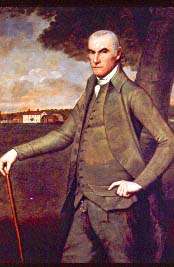William Floyd
| William Floyd | |
|---|---|
 | |
| Member of the U.S. House of Representatives from New York's 1st district | |
|
In office March 4, 1789 – March 3, 1791 | |
| Preceded by | New district |
| Succeeded by | Thomas Tredwell |
| Personal details | |
| Born |
December 17, 1734 Brookhaven, Province of New York |
| Died | August 4, 1821 (aged 86) |
| Resting place | Westernville Cemetery, Westernville, New York |
| Political party | Democratic-Republican |
| Signature |
 |
William Floyd (December 17, 1734 – August 4, 1821) was an American politician from New York, and a signer of the United States Declaration of Independence.
Life and work
Floyd was born in Brookhaven, Province of New York on Long Island, into a family of English and Welsh origins, and took over the family farm when his father Nicholl Floyd died. The William Floyd Estate consists of the home, grounds and a cemetery of the Floyd family. Over the course of 200 years, eight generations of Floyds have managed the 25-room mansion and 613-acre property.[1] Prior to the 20th century, the estate was much larger.[2]
William's great-grandfather Richard Floyd was born in Brecknockshire, Wales in about 1620 and settled in the Province of New York. His grandfather Richard after 1688 purchased 4,400 acres from the Tangier Smith family in the Mastic Neck of the Town of Brookhaven. His father Nicoll built a house there in 1723 that would become the birthplace of William, who was a member of the Suffolk County Militia in the early stages of the American Revolutionary War, becoming Major General. He was a delegate from New York in the First Continental Congress from 1774 to 1776. He was a member of the New York State Senate (Southern District) from 1777 to 1788.
On July 4, 1787, he was elected an Honorary Member of the New York Society of the Cincinnati. In March 1789, he was elected to the 1st United States Congress under the new Constitution as an Anti-Administration candidate and served until March 3, 1791. Floyd was a presidential elector in 1792, voting for George Washington and George Clinton. Floyd, for whom the town of Floyd, New York is named, became a resident of Oneida County in 1794. He is buried at the Westernville Cemetery in Oneida County.[3]
In 1795, Floyd ran for Lieutenant Governor of New York with Robert Yates on the Democratic-Republican ticket, but they were defeated by Federalists John Jay and Stephen Van Rensselaer. Floyd was again a presidential elector in 1800, voting for Thomas Jefferson and Aaron Burr; and in 1804, voting for Thomas Jefferson and George Clinton. Floyd was again a member of the State Senate (Western District) in 1808.
In 1820, Floyd was again chosen a presidential elector, but did not attend the meeting of the electoral college, and Martin Van Buren was appointed to fill the vacancy. In the 1820 Census, when Floyd was 86, he had 6 slaves and 2 free black residents lived in his household[4] at the General William Floyd House in Westernville, New York. The William Floyd House, the family home, is located in Mastic Beach, is part of Fire Island National Seashore and is open to visitors.[5]
Family and Descendants
John Gelston Floyd was his grandson.
Namesakes
There are several places and institutions named after William Floyd, including:
- William Floyd School District in present-day Brookhaven Town, which includes William Floyd Elementary, William Floyd middle school, and William Floyd High School.
- William Floyd Parkway in the Town of Brookhaven.
- Town of Floyd in Oneida County.[6][7]
- General William Floyd Elementary School in the Holland Patent School District in Oneida County
- Floyd Memorial Library in Greenport, Suffolk County, New York
Sources
- United States Congress. "William Floyd (id: F000224)". Biographical Directory of the United States Congress.
- Biography by Rev. Charles A. Goodrich, 1856
- The New York Civil List compiled by Benjamin Franklin Hough (1863; page 165)
References
- ↑ William Floyd Estate
- ↑ William Buck Dana, the husband of Katherine 'Kitty' Floyd (William's great granddaughter) carved out a settlement between the five children of John G. Floyd – Katherine, Sarah, August, John Jr. and Nichol. Sarah and Kitty were each given about 200 acres initially. John Jr got the 600+ acre piece that is what remains today of the William Floyd Estate and is now in control of the National Park Service. August got a large piece just north of that and also the Woodhull estate that became the original section one of Mastic Beach. Nichol's land was just north of Gus'. Kitty was also given a separate deed in 1880 for 20 prime acres that fronted on both the south shore of the Poospatuck Creek and 1500 feet on the western bank of Forge River aka Mastic River.
- ↑ The General William Floyd House
- ↑ Slavery in Oneida County, New York.
- ↑ Fire Island National Seashore – William Floyd Estate
- ↑ Gannett, Henry (1905). The Origin of Certain Place Names in the United States. Govt. Print. Off. p. 127.
- ↑ Town of Floyd, NY Official Website
| U.S. House of Representatives | ||
|---|---|---|
| Preceded by (none) |
Member of the U.S. House of Representatives from New York's 1st congressional district 1789–1791 |
Succeeded by Thomas Tredwell |
